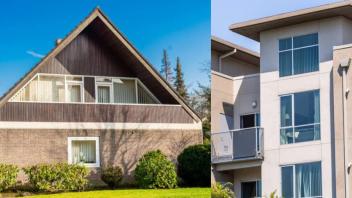The Key Differences Between Built Up Area and Carpet Area
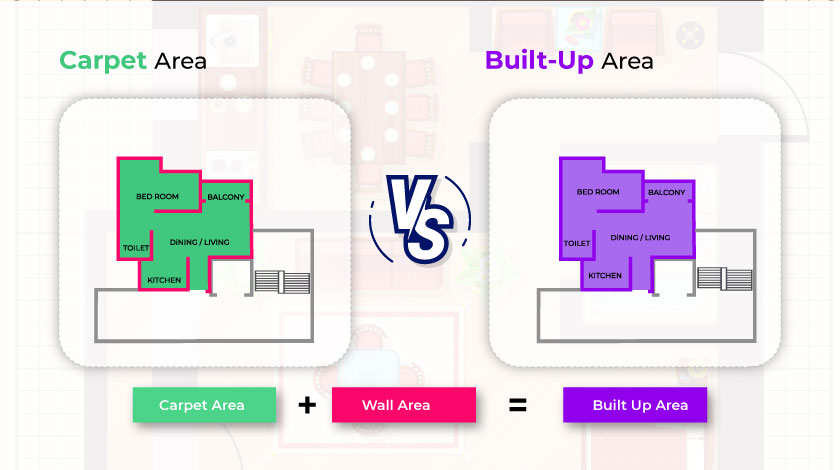
In this blog, we will start by defining what built up area and carpet area are, and then explore the difference between built up area and carpet area. Additionally, we will delve into the concept of RERA carpet area, which has become increasingly relevant with the implementation of the Real Estate Regulatory Authority (RERA) guidelines.
By the end of this blog, you'll have a clear understanding of these terms and why it's important to be aware of them when buying property.
What is Built-Up Area?
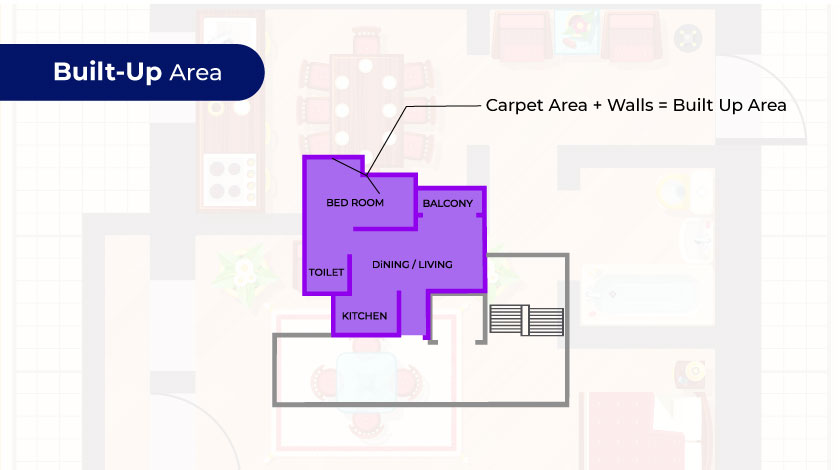
The built up area of a property is a term used to describe the total floor area of an apartment or building, including the thickness of the walls and other structural elements. This measurement extends beyond the carpet area to encompass the entire space within the outer walls of the unit.
Components Included in the Built Up Area
The built up area includes several key components, like:
- Walls: The thickness of both internal and external walls.
- Balconies: The area of any balconies attached to the unit.
- Terraces: Any private terrace space.
- Utility Areas: Utility areas such as ducts or air conditioning platforms.
Note: The built up area does not include common areas shared with other residents, which are part of the super built area.
How Built Up Area is Calculated?
To calculate the built up area, you start with the carpet area and add the thickness of the walls, balconies, and other structural elements. The formula can be summarized as:
Built Up Area=Carpet Area+Wall Area+Balcony Area
For example, if the carpet area of an apartment is 800 square feet, the walls take up 100 square feet, and the balconies add another 50 square feet, the built up area would be:
800 sq ft(CarpetArea)+100 sq ft(WallArea)+50 sq ft(BalconyArea)=950 sq ft
What is Carpet Area?
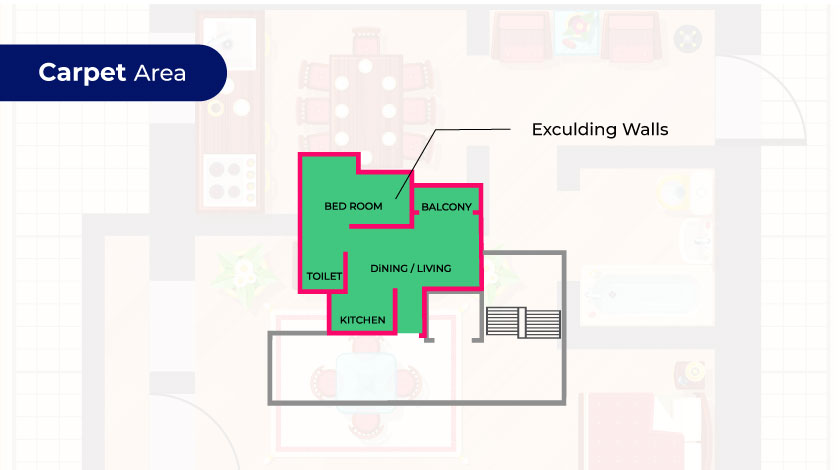
The carpet area of a property refers to the actual usable floor space within the walls of an apartment or building, where you can lay a carpet. It is the area that you can walk on and use for various purposes, excluding the thickness of the walls and other structural components.
Components Included and Excluded in Carpet Area
The components of carpet area includes:
- Bedrooms, Living Rooms, and Dining Areas: All the primary living spaces.
- Kitchen and Utility Areas: The floor space of the kitchen and any attached utility rooms.
- Bathrooms and Toilets: The usable area within these rooms.
- Internal Staircase (if any): The space taken up by stairs within the apartment.
The carpet area does not include:
- Balconies: These are not considered part of the usable floor area.
- Walls: The thickness of internal and external walls.
- Common Areas: Shared spaces like lobbies, lifts, and corridors, which are included in the super built area.
How Carpet Area is Calculated?
To calculate the carpet area, you measure the total usable floor space within the walls of the property. The formula for calculating the carpet area is straightforward:
Carpet Area=Usable Floor Area within the Walls
For instance, if the living room measures 300 square feet, the bedroom is 200 square feet, the kitchen is 100 square feet, and the bathrooms and utility areas total 100 square feet, the carpet area would be:
300 sq ft (Living Room)+200 sq ft (Bedroom)+100 sq ft (Kitchen)+100 sq ft (Bathrooms and Utility Areas)=700 sq ft
Difference between Built-Up Area and Carpet Area
Understanding the difference between built up area and carpet area is essential for making informed real estate decisions.
Comparative Explanation of the Two Terms
- Carpet Area: This is the actual usable floor area within the walls of an apartment, excluding the thickness of the inner and outer walls, balconies, and common areas. It is the area where you can lay a carpet, hence the name. The carpet area is crucial as it indicates the true usable space within a property.
- Built Up Area: This includes the carpet area plus the thickness of the walls and other structural elements like balconies and terraces. It provides a broader measurement that encompasses both usable and non-usable spaces within the confines of the apartment.
Table to Show the Difference Between Built Up and Carpet Area
| Component | Carpet Area | Built Up Area |
|---|---|---|
| Usable Floor Area | Yes | Yes |
| Internal Wall Thickness | No | Yes |
| External Wall Thickness | No | Yes |
| Balconies | No | Yes |
| Terraces | No | Yes |
| Common Areas | No | No |
Practical Examples to Highlight the Differences in Measurements
Example 1: Apartment with 1,000 sq ft Carpet Area
- Living Room: 400 sq ft
- Bedroom: 300 sq ft
- Kitchen: 150 sq ft
- Bathrooms and Utility Areas: 150 sq ft
- Total Carpet Area: 1,000 sq ft
For the same apartment, if the walls, balconies, and other structural elements add up to 200 sq ft, the built up area would be:
Built Up Area=1,000 sq ft (Carpet Area)+200 sq ft (Walls, Balconies, etc.)=1,200 sq ft
Example 2: Apartment with 800 sq ft Carpet Area
- Living Room: 300 sq ft
- Bedroom: 200 sq ft
- Kitchen: 150 sq ft
- Bathrooms and Utility Areas: 150 sq ft
- Total Carpet Area: 800 sq ft
For this apartment, if the additional spaces account for 160 sq ft, the built up area would be:
Built Up Area=800 sq ft (Carpet Area)+160 sq ft (Walls, Balconies, etc.)=960 sq ft
Also Read: Built-up area VS Super built-up area
What is RERA Carpet Area?
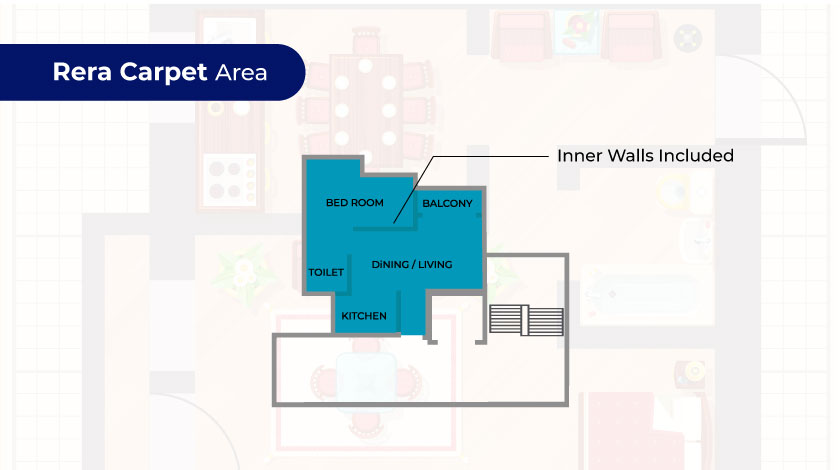
The RERA carpet area is defined as the net usable floor area of an apartment, excluding the area covered by external walls, areas under service shafts, exclusive balconies or verandahs, and exclusive open terraces. However, it includes the area covered by internal partition walls of the apartment.
How RERA Carpet Area Differs from the Traditional Carpet Area
Traditional definitions of carpet area varied, often leading to confusion and inconsistency. With RERA, there is a clear, uniform definition that all developers must adhere to, reducing the chances of misleading information.
While the traditional carpet area might exclude certain internal walls or areas, the RERA carpet area includes all internal partition walls, providing a more comprehensive measurement of the actual usable space within the apartment.
Importance of RERA Carpet Area for Buyers
Understanding the RERA carpet area is crucial for buyers for several reasons:
- Transparency: The standardized definition ensures that buyers receive accurate and consistent information about the usable space in a property. This helps in making better-informed decisions.
- Comparison: With a uniform definition, it becomes easier for buyers to compare different properties on a like-for-like basis. This eliminates the confusion that often arises from varying definitions of built up area and carpet area.
- Value for Money: Knowing the precise RERA carpet area helps buyers understand the actual usable space they are paying for, ensuring they get value for their money. It prevents developers from inflating the size of the apartment by including non-usable areas.
- Legal Protection: RERA regulations provide legal recourse for buyers if the actual RERA carpet area delivered is less than what was promised, protecting buyers from potential fraud or discrepancies.
Why is it Important for Buyers to Know these Terms?
Understanding the difference between built up area and carpet area is crucial for anyone looking to buy or invest in real estate. These terms play a significant role in determining the actual usable space of a property and can greatly impact your purchasing decision.
- Accurate Assessment of Usable Space: Understanding the difference between built up area and carpet area helps buyers accurately assess the actual usable space within a property, avoiding misconceptions about the size of the property.
- Informed Decision Making: Knowledge of these terms ensures that buyers can make informed decisions, comparing properties based on the true usable area rather than inflated figures that include non-usable spaces.
- Transparency and Clarity: With the standardized RERA carpet area, buyers can trust the measurements provided, reducing the risk of being misled by varying definitions used by different developers.
- Better Financial Planning: Knowing the actual usable space helps in better financial planning, as buyers can evaluate if the property meets their needs and is worth the investment.
- Legal Protection: Understanding these terms provides buyers with legal protection under RERA guidelines, ensuring that the promised carpet area is delivered and any discrepancies can be legally challenged.
Impact on Property Pricing and Decision Making
- Price Evaluation: Properties are often priced based on the built up area or super built area, but the actual usable carpet area determines the value. Understanding these terms helps buyers evaluate the price more accurately.
- Comparison of Properties: Knowing the difference between built up area and carpet area allows buyers to compare properties on a like-for-like basis, ensuring they get the best deal for the usable space offered.
- Negotiation Power: Armed with knowledge about carpet area, built up area, and super built area, buyers can negotiate better prices, ensuring they are not overpaying for non-usable spaces.
- Understanding True Value: Buyers can better understand the true value of a property by focusing on the RERA carpet area, which provides a clear picture of the actual living space, leading to more sound investment decisions.
- Avoiding Hidden Costs: Awareness of these terms helps buyers avoid hidden costs associated with non-usable areas, ensuring that they are only paying for the space they will actually use.
Tips for Buyers on Using this Knowledge During Property Purchase
- Compare Properties Accurately: Always compare properties based on the RERA carpet area to understand the true usable space. This ensures you are making an apples-to-apples comparison and not being misled by inflated built up area or super built area figures.
- Ask for Clear Breakdown: When presented with property details, ask the developer for a clear breakdown of the carpet area, built up area, and super built area. This transparency helps you see how much of the space is actually usable.
- Verify with RERA Guidelines: Ensure the property measurements adhere to RERA guidelines. The RERA carpet area provides a standardized measure, reducing the risk of discrepancies.
- Consider Long-Term Usability: Focus on the carpet area when assessing whether the property meets your needs. A larger built up area with a smaller carpet area may not provide the functional space you require.
- Negotiate Based on Usable Space: Use your understanding of these terms to negotiate better prices. If a property has a high built up area but a relatively small carpet area, you can argue for a lower price based on the actual usable space.
Wrapping Up: Why Understanding Property Measurements Matters
In this blog, we’ve explored the critical distinctions between built up area and carpet area. We started by defining each term, explaining what constitutes carpet area and built up area, and highlighting the difference between built up area and carpet area. We also delved into the standardized RERA carpet area and its importance in ensuring transparency and fairness in real estate transactions.
Understanding these property measurements is essential for any potential buyer. The carpet area represents the actual usable space, while the built up area includes additional structural elements. Recognizing these differences can significantly impact your decision-making process, ensuring you make informed and financially sound investments.
Being well-informed about these terms not only helps you evaluate properties accurately but also empowers you to negotiate better deals and avoid overpaying for non-usable spaces. The introduction of RERA carpet area has further standardized these measurements, offering buyers a clearer and more reliable metric for assessing properties.
By understanding these key property metrics, you can make confident and informed real estate investments, ensuring you get the best value for your money.











